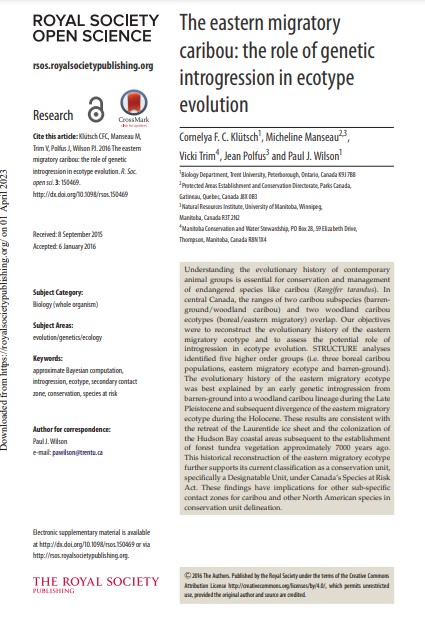The eastern migratory caribou: the role of genetic introgression in ecotype evolution
Bosque Modelo:
Prince Albert
Temática:
Conservación
Tipo de documento:
Artículo científico
Resumen
Understanding the evolutionary history of contemporary animal groups is essential for conservation and management of endangered species like caribou (Rangifer tarandus). In central Canada, the ranges of two caribou subspecies (barrenground/woodland caribou) and two woodland caribou ecotypes (boreal/eastern migratory) overlap. Our objectives were to reconstruct the evolutionary history of the eastern migratory ecotype and to assess the potential role of introgression in ecotype evolution. STRUCTURE analyses identified five higher order groups (i.e. three boreal caribou populations, eastern migratory ecotype and barren-ground). The evolutionary history of the eastern migratory ecotype was best explained by an early genetic introgression from barren-ground into a woodland caribou lineage during the Late Pleistocene and subsequent divergence of the eastern migratory ecotype during the Holocene. These results are consistent with the retreat of the Laurentide ice sheet and the colonization of the Hudson Bay coastal areas subsequent to the establishment of forest tundra vegetation approximately 7000 years ago. This historical reconstruction of the eastern migratory ecotype further supports its current classification as a conservation unit, specifically a Designatable Unit, under Canada’s Species at Risk Act. These findings have implications for other sub-specific contact zones for caribou and other North American species in conservation unit delineation.
Información Bibliográfica
Autor:
Klutsch, Cornelya F. C.; Manseau, Micheline; Trim, Vicki; Polfus, Jean; Wilson, Paul J.
Revista:
ROYAL SOCIETY OPEN SCIENCE
Año:
2016
N°:
2
País :
Canadá
Páginas:
1 - 13
Volumen:
3
Idioma:
Ingles
Palabras claves
approximate Bayesian computation, introgression, ecotype, secondary contact zone, conservation, species at risk





